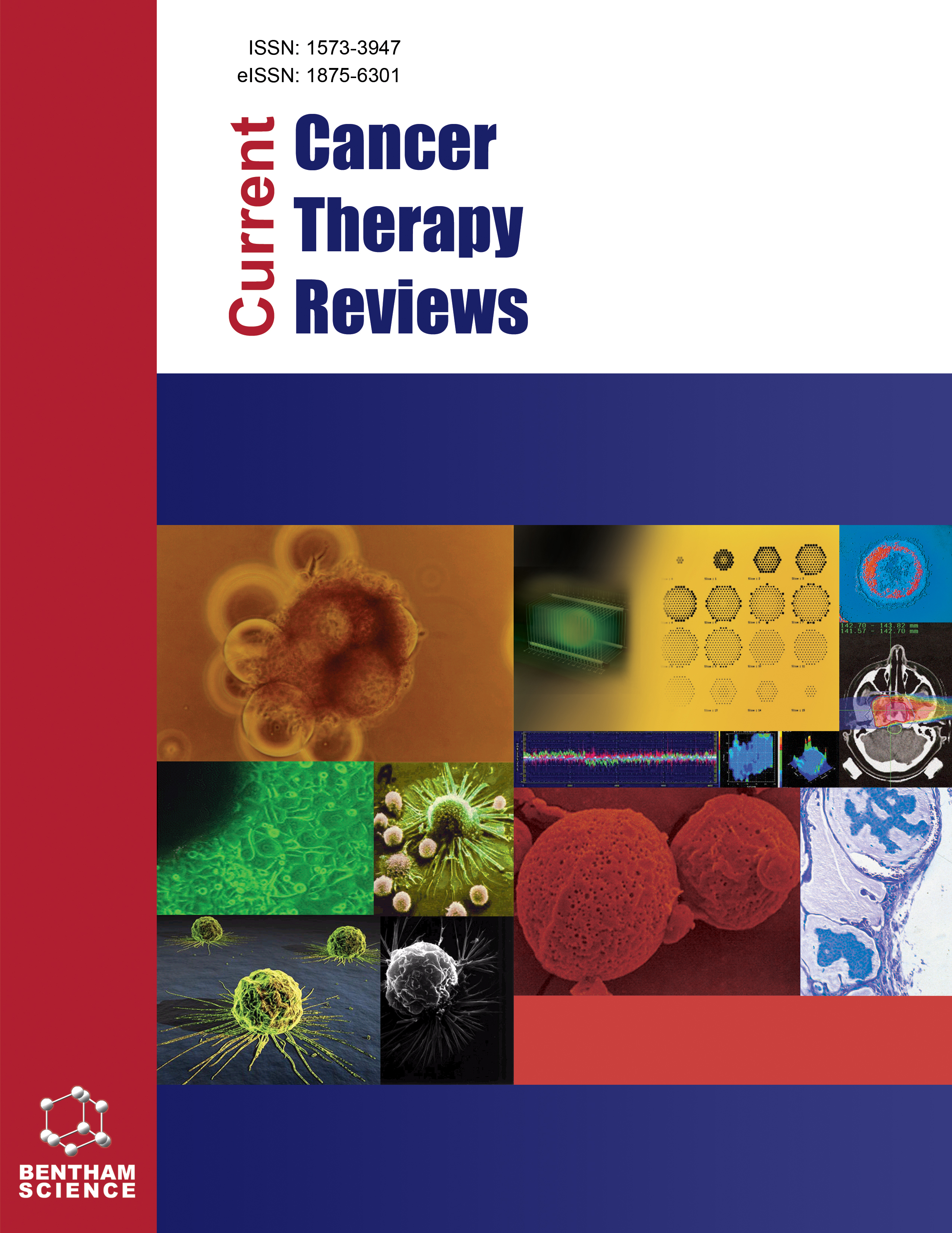- Home
- A-Z Publications
- Current Cancer Therapy Reviews
- Previous Issues
- Volume 1, Issue 3, 2005
Current Cancer Therapy Reviews - Volume 1, Issue 3, 2005
Volume 1, Issue 3, 2005
-
-
Role of Polyamines in Breast Cancer Growth, Development and Progression
More LessBy Andrea ManniThe polyamines putrescine, spermidine, and spermine are small, aliphatic amines that play an important role in multiple cellular functions. Activation of the polyamine pathway is involved in carcinogenesis and other aspects of tumor biology including in breast cancer. Levels of ornithine decarboxylase (ODC), the first and rate-limiting enzyme in polyamine biosynthesis as well as the levels of polyamines, are higher in hum Read More
-
-
-
Bisphosphonate Therapy for Patients with Breast Cancer
More LessBy Allan LiptonBisphosphonates have been widely used over the past decade to prevent skeletal complications in breast cancer patients with bone metastases. The skeletal complications associated with bone metastases include severe bone pain, pathologic fractures, spinal cord compression, and hypercalcemia. A number of bisphosphonates, including oral clodronate, intravenous (IV) pamidronate, IV zoledronic acid, and ibandron Read More
-
-
-
Recent Advances in Combined Modality Treatment for Locally Advanced Pancreatic Cancer
More LessAuthors: Gorkem Aksu, Binnaz Sarper, Cuneyt Ulutin and Hakan BakkalPancreatic cancer is one of the most resistant cancers to conventional treatment modalities and is generally in the locally advanced or metastatic stage at the time of initial diagnosis. Approximately only 20% of patients are diagnosed as potentially resectable but 5-year survival rate is no more than 20-25% even in these resectable ones. Realizing the poor prognosis with a single-modality approach, several studies that used the Read More
-
-
-
Liposomal-All-trans-Retinoic Acid in the Treatment of Acute Promyelocytic Leukemia
More LessAuthors: Bulent Ozpolat, Maribel Tirado-Gomez and Gabriel Lopez-BeresteinThe great success of all-trans-retinoic acid (ATRA) in the treatment of acute promyelocytic leukemia (APL) revolutionized the treatment of the disease and introduced the concept of differentiation therapy. ATRA, a physiologic derivative of vitamin A (retinol), induces complete clinical remissions (CR) in majority of patients with APL, M3 type of acute myeloid leukemia (AML). In contrast to the cytotoxic chemotherapeuti Read More
-
-
-
Antioxidant Supplements, Genetics and Chemotherapy Outcomes
More LessAuthors: Christine B. Ambrosone, Jiyoung Ahn and Vreni SchoenenbergerCancer patients report widespread use of antioxidant supplements during chemotherapy, despite recommendations by the American Institute for Cancer Research and others that supplements should not be used during treatment. These guidelines are based upon the fact that numerous chemotherapeutic agents, as well as radiation therapy, exert their cytotoxic effects by generation of reactive oxygen species (ROS), whi Read More
-
-
-
IP6 & Inositol in Cancer Prevention and Therapy
More LessAuthors: Abul K.M. Shamsuddin and Ivana VucenikInositol and its phosphorylated form - inositol hexaphosphate (IP6) are naturally occurring carbohydrates, abundantly found in certain high-fiber diets, such as cereals and legumes. They, as well as other inositol phosphates with fewer phosphate groups (IP1-5) are contained in almost all mammalian cells, although in much smaller amounts, where they are important in regulating vital cellular functions. A striking anticance Read More
-
-
-
An Emerging Molecular Target in Melanoma: Cellular Carbonyl Stress and the Inhibition of Mitochondrial Survival Pathways by Carbonyl Scavenger Agents
More LessAuthors: Georg T. Wondrak, Myron K. Jacobson and Elaine L. JacobsonTherapeutic induction of apoptosis is an important goal of anti-cancer drug design. Here, we review briefly the emerging role of cellular carbonyl stress in melanoma proliferative control, antiapoptotic survival signaling, progression, and metastasis. Cellular carbonyl stress mediated by endogenous reactive carbonyl species (RCS) such as glyoxal, methylglyoxal (MG), and malondialdehyde has been implicated in proliferat Read More
-
-
-
Inhibitors of the Hedgehog Signal Transduction Pathway
More LessAuthors: David J. Robbins, John A. Goetz, Ziqiang Yuan and Melanie A. StegmanAberrant Hedgehog (Hh) signaling plays an important role in the pathogenesis and maintenance of many cancers. The mechanisms by which this pathway contributes to tumor progression are only now being unraveled. There appear to be two distinct ways by which Hh signaling becomes constitutively activated in tumors: by over expression of the ligand itself, or by acquisition of mutations in Hh signaling components at or Read More
-
-
-
Experimental Onco-Immunology Revisited
More LessThe search for the cause of cancer has led to five successive theories involving viruses, oncogenes, tumor suppressor genes, somatic mutation cascade and inflammation. The latter, without discarding the former theories, is now the prevailing paradigm recognizing that neoplastic cells require participation of the microenvironment for tumor progression. Inflammatory reactions are dependent on an overabundance of i Read More
-
Volumes & issues
-
Volume 21 (2025)
-
Volume 20 (2024)
-
Volume 19 (2023)
-
Volume 18 (2022)
-
Volume 17 (2021)
-
Volume 16 (2020)
-
Volume 15 (2019)
-
Volume 14 (2018)
-
Volume 13 (2017)
-
Volume 12 (2016)
-
Volume 11 (2015)
-
Volume 10 (2014)
-
Volume 9 (2013)
-
Volume 8 (2012)
-
Volume 7 (2011)
-
Volume 6 (2010)
-
Volume 5 (2009)
-
Volume 4 (2008)
-
Volume 3 (2007)
-
Volume 2 (2006)
-
Volume 1 (2005)
Most Read This Month
Article
content/journals/cctr
Journal
10
5
false
en


